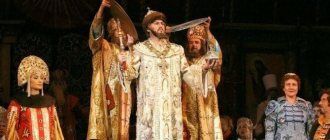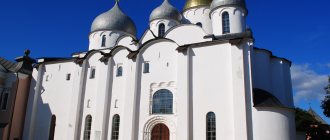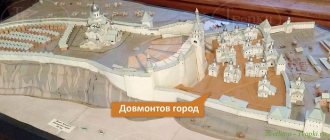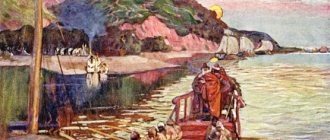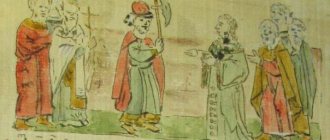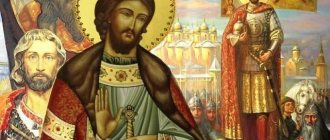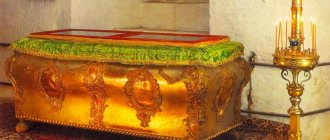| Holy Blessed Prince Andrei Smolensky |
Andrei Pereyaslavsky
(+ c. 1390), Prince of Smolensk, blessed saint Memory October 27 - the discovery of relics in 1539, July 8 (local in the Pereslavl-Zalessky St. Nicholas Convent) - the second discovery of relics in 2000 [1], in the Cathedrals Smolensk and Rostov-Yaroslavl saints
Nothing is known about the initial period of the life of the holy noble prince Andrei, since he hid his origin. Around 1360, Saint Andrew, as a poor wanderer, came to Pereyaslavl (modern Pereslavl-Zalessky) and settled at the church in honor of St. Nicholas at the city gates, after some time he became a sexton and carried out this obedience for 30 years. After the death of the saint, a gold chain and a ring were found on his body - signs of princely dignity, iron chains - a sign of secret asceticism, as well as a small note on which was written in his hand: “I am Andrei, one of the Smolensk princes. Out of envy and sedition from my brothers, I left my reign, and my house, and so on.”
Based on the text of the note, Archbishop. Filaret (Gumilevsky) assumed that Andrei was the son of the Smolensk prince Fyodor the Blind Fominsky, a contemporary of the Grand Duke Simeon the Proud (+ 1353). The Smolensk principality was then fragmented into small parts, the division of any inheritance between the Smolensk princes (there were 17 of them at one time) was accompanied by envy and quarrels. The alleged father of Prince Andrei, Fyodor, went to Tver, and Andrei himself chose the path of humiliation, poverty, secret asceticism and prayer.
The sexton prince was buried at St. Nicholas Church, his body wrapped in birch bark. Subsequently, the gold chain and ring were taken by Vel. book John III Vasilyevich, who gave for them to the church of St. Nikolai's friend. It was probably then that a service to the blessed Prince Andrei was compiled, an icon was painted, that is, local glorification was performed; The saint's chains were kept in the church.
During the time of St. Daniel of Pereyaslavl (1453-1540), possibly due to the desolation of the Church of St. Nicholas, the celebration of the memory of the blessed Prince Andrei was no longer celebrated. St. Daniel, a native of Pereyaslavl, knew well the oral traditions about the holy prince, visited the temple where he once served as a sexton, saw his grave, chains and image and decided to resume the celebration of his memory. In 1539, while in Moscow on monastery business, St. Daniel asked for funds from the young sovereign John IV Vasilyevich, his godson, and from Metropolitan. Joasaph for the renovation of dilapidated Pereyaslavl churches in the name of John the Baptist and in the name of St. Nicholas. St. Daniel also told the Tsar and the Metropolitan that the relics of Saint Prince Andrew lay at the St. Nicholas Church, and that a church service had previously been performed for him, and received a blessing to examine the remains of the saint. Returning to Pereyaslavl, St. Daniel opened the grave and examined the relics of the prince, without removing them from the ground: “His relics were seen as if bathed in myrrh, like a certain fragrance emanating... The hair of the head of Russia, and the greatness, and the goals of the byahu, and like the light of the light, and his vestments... found from above heads and feet for one country, as if they were wrapped in byakhu, and on them byakhu were copper buttons.”
[2]. Many sick people received healing from the relics of the saint.
According to the report of Rev. Daniil, archimandrites arrived from Moscow. Miracle Monastery Jonah (Sobina) and the archpriest of the Assumption Cathedral Gury, but they did not believe in the holiness of the prince and even reproached Daniel for unauthorized witnessing of the relics. The monk was greatly upset, he began to cry and said that he did not act arbitrarily, but with the permission of the Tsar and the Metropolitan, who ordered him to examine the relics of Saint Andrew; pointed to his image; referred to the service of the saint. Finally, he introduced three people who received healing from ailments during the opening of the relics: the ruler of the royal villages, John Oklyacheev, said that he was healed of a long-term headache after touching the relics of the holy prince; one woman from Pereyaslavl said that for three years she suffered from a severe throat disease, could not utter a word, but when, at the discovery of the relics of St. Andrew, she took a piece of birch bark and swallowed it, she immediately felt relieved and began to speak; another woman also, with the help of birch bark from the relics of the saint, was healed from a long-term major illness. But neither the arguments of the Monk Daniel, nor the attested miracles of the holy Prince Andrew convinced Jonah and Guria. Jonah turned to the monk with the following words: “The Right Reverend Metropolitan did not tell me anything about the holy relics and did not give any orders.” This meant that Metropolitan Joasaph left the matter to the decision of Jonah and Guria themselves, and they considered the evidence of the holiness of Prince Andrew insufficiently clear and refused to glorify the saint of God with a church celebration.
The Monk Daniel was greatly upset by the decision of the Metropolitan and the investigators he sent and predicted that for their lack of faith in the holiness of the saint of God, all three would suffer sorrow: the Metropolitan would soon be dethroned, he predicted various misfortunes for Jonah, and the deprivation of his beloved son for Guria. At first they were embarrassed when they heard the formidable predictions of the ascetic, then they said that due to old age he had lost his senses (at that time the monk was 80 years old) and was saying inappropriate things.
The relics of Prince Andrei were covered with shrouds, placed in a new coffin and buried.
| Holy Blessed Prince Andrei Smolensky. Icon by nun Catherine (Omelchenko), 2000. Annunciation Church of the St. Nicholas Convent, Pereslavl-Zalessky |
E. E. Golubinsky believed that the metropolitan’s representatives were not satisfied with the small number of miracles and the paucity of information about the life of Prince Andrei.
The researcher believed that the petition of Rev. Daniel's request for the resumption of the church celebration of the memory of the holy prince was not successful. This conclusion is not indisputable, Rev. Daniel was undoubtedly denied permission to have the saint's relics remain "until opening," but whether the resumption of the celebration of his memory was denied remains unclear. In the service to Prince Andrey it is stated that a local celebration for him was established in 1539. Even if the celebration of the memory was initially prohibited, the ban was probably soon lifted, since all the predictions of St. Daniel were fulfilled exactly. Instead of the dethroned Metropolitan. Joasaph, St. joined the Moscow See in 1542. Macarius. With the blessing of the saint and the command of Tsar John IV, the life of St. Daniel. The story about the discovery of the relics of the blessed Prince Andrei in 1539, placed in this life, was probably confirmed by the establishment of the celebration of the memory of the blessed Prince Andrei. It can be assumed that the secondary establishment of local celebration dates back to the time of completion of work on the life - in 1563. Subsequently, the name of the holy noble prince Andrei of Smolensk was included in the calendar. On October 27, “the discovery of the relics of the holy blessed prince Andrei of Smolensk, also in Pereyaslavl Zalessky”
noted in the Monthly Book of Simon (Azaryin) ser. 1650s [3]. In addition, the saint’s memory on November 30 is noted in the Kaidalovsky calendar. XVII century [4]. By the decree of the Pereyaslav Consistory of August 14, 1749, it was prescribed to commemorate Saint Prince Andrew at litias and dismissals throughout the Pereyaslav diocese [5].
It can be assumed that after the discovery of the relics of the blessed Prince Andrei, they were placed under cover inside the restored wooden church of St. Nicholas, which has since been called the Church of the Blessed Virgin Mary. book Andrey.
During one of the fires, the church completely burned down, but the tombstone of the blessed prince, on which there was a shroud and icons of the Most Holy Theotokos and the saint, remained intact.
In 1714, on the site of the wooden church, a stone one was built and a nunnery in the name of the Blessed Virgin Mary was established with it. book Andrei Smolensky, abolished in 1764 [6]. The church became a parish church and was destroyed during Soviet times.
The second discovery of the relics of St. Andrew took place on July 21, 2000, and a wooden cross was installed at the site of discovery. Currently, the relics rest in the Pereslavl-Zalessky Nikolsky convent in the Swamp.
In the Menaion (MP) on October 27, the day of the discovery of the relics of the Blessed Virgin Mary. book Andrew, a vigil service has been held. During the service of the Cathedral of Rostov-Yaroslavl Saints, St. Andrew is mentioned in the book of verse stichera of Vespers, as well as in the third troparion of the eighth canon of the Matins canon.
The life of the blessed prince Andrei of Smolensky [7] is an extract from the life of St. Daniil Pereyaslavsky with a short introduction. Life of St. Daniel was compiled, according to some researchers, in 1562-1563 (N. N. Pokrovsky), according to others - in 1556-1563 (S. I. Smirnov, O. A. Belobrova) by the confessor of Tsar Ivan IV Vasilyevich the Terrible , the future Metropolitan of Moscow Athanasius, who was born in Pereyaslavl, in 1530-1549 was the rector of the cathedral church of the city, a witness to the life of St. Daniel and his disciple [8].
One of the earliest images of the saint is a fresco of 1662-1668, made by the artel of Gury Nikitin, on the southern edge of the southwestern pillar of the Trinity Cathedral of the Pereslavl-Zalessky Danilov Monastery. The saint is presented full-length, frontally, in princely clothes: a dark cherry dress, decorated with floral patterns and borders, with a belt, in a blue-green cloak, fastened on the chest with a fibula; the right hand with an open palm, the left hand down; he has shoulder-length dark brown hair, parted in the middle, and a short rounded beard.
In the iconographic original of the late 18th century. [9] about the appearance of the holy Prince Andrew it is said: “Like Nikita the martyr with brad, and hair over his plaid, a cross in his hand, a sword in his left, princely vestments.”
The trace of his half-length image on an icon of the 17th century has been preserved. [10].
Life of the Saint
The Monk Andrei ended up in Pereslavl-Zalessky. It was there that he served as a sexton in the Church of St. Nicholas for four decades, where he died and was buried. At first the ascetic lived at the gates of the Church of St. Nicholas the Wonderworker, then he became a sexton there. Initially, the prince did not set out to live in this city.
Blessed Prince Andrei Smolensky
He put his fate in the hands of the Lord and completely relied on Divine Providence, asking the Almighty to show him the right path. So he wandered through various cities and villages until he came to Pereslavl-Zalessky. The prince felt the need to stay and live here and subsequently spent many years in this city.
Many began to say that Andrei Smolensky was revered as a Saint in vain, because he did not perform significant feats. But the very decision to leave your family, to renounce your noble origin, to be a poor servant of a small temple in a foreign city is an act that not every person can do.
Saint Andrew spent his days at the church in constant work and prayer. He took part in all church services, after which he did the necessary physical and manual labor. Often the righteous man spent whole nights in prayer, kneeling at the iconostasis.
The Saint meekly endured all the hardships of life and hardships, without complaining or grumbling about his fate. To emphasize that the spiritual principle is more important than the carnal, the Saint wore heavy metal chains on his body, with which it was difficult even to walk. At the same time, he did not refuse any difficult physical work, which once again emphasizes his enormous fortitude.
The prince was infinitely far from acquisitiveness; material wealth meant nothing to him. Such self-denial was surprisingly combined with love for others. Everyone who personally knew the righteous man noted his boundless meekness, kindness and desire to help everyone.
Interesting! After the death of Andrei Smolensky, a princely ring, gold chains, and a note in which the righteous man spoke about his origin were found next to his body. Before burial, the Saint's body was wrapped in a birch bark sheet, then the prince was buried not far from the temple in which he spent many years.
After the end of his earthly journey, the life of the sexton of the Church of St. Nicholas was not forgotten. Many Christians and members of the clergy considered the prince a Saint and celebrated the day of his repose. Then icons of the new Saint were painted, akathists and canons were created.
But over time, they began to forget about the ascetic. Everything changed when the Monk Daniel began his spiritual path in the same temple. He read a lot about the life of Andrei Smolensky and believed that his exploits were undeservedly ignored, while they should not be consigned to oblivion. That is why the Monk Daniel decided to make every effort to glorify Prince Andrew throughout the centuries.
PUBLICATIONS
November 9 / October 27 (Old style) - The Church commemorates the holy noble Prince Andrei of Smolensk.
Holy Blessed Prince Andrei Smolensky
The holy noble Prince Andrey, according to the assumption of the Right Reverend Philaret, Bishop of Chernigov, is the son of the Smolensk prince Theodore Konstantinovich (Fominsky), who from the early forties of the 14th century became the appanage prince of Vyazemsky and in 1340 went to Smolensk under the banners of Moscow. At that time, Ivan Alexandrovich, the grandson of Gleb (from the Davidovich family), reigned there. Constant strife between the descendants of princes Rurik and David Rostislavovich forced Prince Theodore to soon retire to Moscow. Other historians believe that the blessed Prince Andrei and Prince Andrei Mikhailovich Vyazemsky, who reigned in the city during the reign of Alexander Glebovich in Smolensk, are one person.
In Vyazma, especially from the middle of the 14th century, when the princes of Smolensk lost their Mozhaisk (1303) and Bryansk possessions (1356), they did not feel very calm and were always afraid of claims from their relatives. Prince Andrey, still at a young age, burdened by the infighting of his cousins, renounced his inheritance, left his hometown, and around 1360, as a simple wanderer, came to Pereslavl-Zalessky. He lived here in humility and meekness for thirty years, serving all these years as a simple sexton in the church in the name of St. Nicholas the Wonderworker at the city gates, near which he was buried, and his body was wrapped in birch bark.
After the death of Prince Andrei, which followed on October 27 / November 9 (NST) 1390, they discovered a hereditary princely ring, a gold chain and a note with the words: “I am Andrei, one from the Smolensk princes.”
The gold chain and ring from the St. Nicholas Church were later transferred to Moscow to Grand Duke John Vasilevich, who reigned from 1462 to 1505. For this he gave the church a monetary allowance (rugu). The chains of the blessed Prince Andrei were kept in the St. Nicholas Church for a long time. After the death of the faithful prince-sacristan, the residents of Pereslavl-Zalessky began to venerate him as a saint and celebrate the memory of the ascetic on the day of his repose - October 27, painted his image, compiled a service, special stichera and a canon.
In 1539, the Venerable Daniel of Pereslavl, the founder of the Holy Trinity Monastery in Pereslavl-Zalessky, while in Moscow, turned to the young sovereign Ivan Vasilyevich IV (the Terrible), his godson and Metropolitan Joasaph with a request to allocate funds for the repair of dilapidated city churches built in honor of the prophet John the Baptist and in the name of St. Nicholas. The Monk Daniel told the Tsar and the Metropolitan that the relics of the blessed Andrei, Prince of Smolensk, lay hidden at the St. Nicholas Church, and asked permission to examine them. The sovereign allocated funds from his treasury for the construction of new churches on the site of the dilapidated ones and, together with the metropolitan, allowed the Monk Daniel to open the grave of Prince Andrei and examine his relics. After the prayer service, the tombstone was dismantled, the grave was dug up, and the coffin was opened. Despite the fact that the body, wrapped in birch bark, lay in the ground for about one hundred and fifty years, it was completely preserved. The relics turned out to be incorrupt and emitted a fragrance, the hair was brown and long, the clothes were intact, with copper buttons. Having examined the relics of the blessed Prince Andrew, the Monk Daniel sent a report to the Tsar and the Metropolitan.
From Moscow they sent Archimandrite Jonah of the Chudov Monastery and Archpriest of the Assumption Cathedral Gury to make an official decision, to whom Metropolitan Joasaph left the matter of examining the relics to their own discretion. They considered the testimony of the holiness of the blessed Prince Andrei insufficient for glorification. An order was received from them to again bury the body of Prince Andrei. The Monk Daniel was greatly upset by the decision of the Metropolitan and his envoys, predicting to them that for their lack of faith in the holiness of the saint of God, all three would suffer sorrow: the Metropolitan would soon be dethroned, Gury would lose his beloved son, and various misfortunes would befall Jonah. These prophecies of the reverend elder, who at that time was already eighty years old, came true exactly.
The ascetic’s concerns about the glorification of the blessed Prince Andrei were not in vain. The memory of the holy prince, revived by the Monk Daniel, remained with the residents of Pereslavl-Zalessky, and his memory continued to be celebrated locally. By decree of the Holy Synod of 1749, this local celebration of the blessed Prince Andrei was officially approved.
Many miracles were performed at the relics of Saint Prince Andrew. So, during one of the fires, the wooden St. Nicholas Church burned to the ground, but the tomb of the holy prince, his image standing nearby, the shroud and the icon of the Mother of God remained intact and unharmed.
Currently, the relics of the holy blessed Prince Andrei have been found and rest in a specially constructed shrine in the cathedral church of the St. Nicholas Convent in the city of Pereslavl-Zalessky.
On the icons he is depicted: “in the likeness of a Russian, with a bald head, a brad like Nikita the martyr, a prince’s robe, a cross in his hand, a sword in the other.”
Hieromonk Daniil (Sychev)
Glorification of the memory of Andrei Smolensky
One day the Monk Daniel was in Moscow, where he met with Emperor Ivan the Terrible. He told the monarch about the problems of the dilapidated churches of Pereslavl, and that the relics of Andrei Smolensky were kept in one of the churches. He spoke about the spiritual exploits of the Saint, conveyed to him all the oral traditions about the ascetic, which were widely known among the Christians of those lands.
Venerable Daniel of Pereyaslavl
The Monk Daniel complained that Andrei of Smolensk might be forgotten if his memory is not maintained and his name is not glorified. After listening to him, the sovereign ordered funds to be allocated from the treasury for the restoration of dilapidated church buildings and to examine the relics of the Saint, removing them from the burial place.
It is important to know! Righteous Daniel is a Saint of the Russian Orthodox Church, revered as a saint. Known as the founder of the Danilovsky Monastery near the city of Pereslavl. Pereslavl-Zalessky is the ascetic’s hometown, where he labored and found a love for Christianity and spiritual achievements.
He devoted his life to pious deeds, helping the people of his homeland. The names of Andrei Smolensky and Daniil Pereyaslavsky always go side by side when people remember the holy ascetics of those lands.
Archimandrite Jonah, who was called to examine the relics of Andrei of Smolensk, was opposed to the examination and canonization of the righteous man. The archimandrite considered the actions of Saint Daniel arbitrary, and no matter how much Daniel tried to explain that such was the will of the monarch, he was unable to prove anything to the abbot of the Chudovsky Monastery.
Literature
- Ponomarev A.I. Monuments of ancient Russian church literature. St. Petersburg, 1898. Issue. 4: Slavic-Russian Prologue. pp. 64-67;
- Smirnov S.I. Life of St. Daniel, the Wonderworker of Pereyaslavl: The Tale of the Finding of Relics and His Miracles. M., 1908;
- Menaea (MP). Oct. pp. 690-712; May. Part 3. pp. 24, 33.
- Filaret (Gumilevsky). RSv. Months September-December. Chernigov, 1865. P. 263-267;
- Klyuchevsky. Old Russian Lives. P. 282;
- Barsukov. Sources of hagiography. Stb. 39-40;
- Filimonov. Iconographic original; Zverinsky; Sergius (Spassky). Monthsword. T. 2. P. 332;
- Golubinsky. Canonization of saints. pp. 86, 152;
- JSV. Book add. 1. Sep.-Dec. pp. 251-256;
- Pokrovsky N. N. Afanasy (in the world Andrey) // SKKDR. Vol. 2. Part 1. pp. 73-74;
- Belobrova O. A. Life of Daniil of Pereyaslavsky // Ibid. pp. 257-259;
- Muravyov A.I. Lives of the saints of the Russian Church, also Iverian and Slavic, and locally revered ascetics of piety. The month is October. M., 1994. pp. 357-365.
- Sergievsky F., priest. The story of the life, exploits and discovery of the relics of St. Andrey, blgv. book Smolensky, Pereslavl miracle worker. M., 1890;
- Markelov. Saints of Ancient Rus'. T. 1. P. 80-81; T. 2. P. 50-51.
Miracle healings
Jonah was not convinced by eyewitness accounts - people who were healed thanks to the help of St. Andrew. The prince's relics were found incorruptible, and during their discovery several miraculous healings occurred:
- When the relics were opened, the manager of a nearby village was healed of a severe headache. Pain of unknown origin tormented him throughout his life, but when he touched the relics of the Saint, it went away. Subsequently, the disease never returned to this person.
- One of the women present during the examination of the relics gained the ability to speak. For her, this was a real miracle, since for many years she had been tormented by a sore throat that did not allow the woman to say a word. After she touched the relics of the righteous man, the pain and feeling of suffocation went away, and the recovered woman was able to speak calmly. The woman’s words were immediately confirmed by her husband, children and neighbors.
- Another woman, taking a piece of birch bark in which the body of the righteous man was wrapped, was cured of a long-term eye disease and gained the ability to see clearly. Previously, she could not even move independently; relatives brought the woman to find the relics. Rubbing her face with a piece of birch bark, she was healed of her illness, as the people who were with her at that moment could testify.
All these miraculous healings could not convince Archimandrite Jonah, and he decided not to leave orders regarding the relics of St. Andrew, placing this responsibility on his companions.
Finding the relics and their further fate
Saint Daniel was very upset by the fact that the exploits of Andrei Smolensky were not recognized. He predicted many troubles for Archimandrite Jonah and his companions because they rejected the blessed memory of the righteous man. The Monk Daniel did not wish them harm, he simply felt that this prophecy would come true.
Reliquary with the relics of Saint Prince Andrei of Smolensk
At first those present were confused, then the archimandrite said that the Monk Daniel was very old, and therefore he was saying inappropriate things. But in the future, all the words of the Saint came true - misfortune befell the archimandrite, the Metropolitan was deprived of his title, and Archpriest Gury lost his son.
When Saint Macarius took this position instead of Metropolitan Josaaph, he gave orders to write a book that would describe the life of Saint Daniel. It also said a lot about Andrei Smolensky, so this issue was again brought up for discussion in church circles.
Important! After this publication, the days of memory of St. Andrew were again included in the calendar, despite the fact that previously it was forbidden to celebrate them and hold solemn services on these days.
The concern of the Monk Daniel for the memory of Andrei Smolensky was not in vain. The Saint began to be remembered more often not only in churches, but also in home prayers. In 1794, the Holy Synod issued a decree in which it was ordered to venerate Prince Andrew among the Saints of God.
Miraculous healings continue for many years after the death of the Saint, but these are not the only unusual events associated with the relics of Prince Andrei. One day, the temple in which the relics of the Saint were kept burned to the ground during a fire. The relics of the righteous man and the icon of the Mother of God, hanging directly above them, remained unharmed.
All the townspeople who participated in putting out the fire saw this miracle and immediately glorified the Lord, the Blessed Virgin and the saint of God Andrew. The temple was rebuilt and stood in this form until the 30s of the last century. During the years of persecution of Christians, the temple was blown up, but the relics of the Saint, kept on the ground floor of the temple, were not damaged.
The second discovery of the Saint’s relics took place 19 years ago. Currently they rest in the St. Nicholas Convent of Pereslavl-Zalessky.
Director of the Research Institute of Sports Medicine Andrey Smolensky: Our doctors are errand boys
- Solid, but let's watch this program. And we will see: there is no theory and methodology of the chosen sport, no dynamic anatomy, biomechanics, sports physiology and other very important subjects that a modern sports doctor should know. At least know that such items exist.
SCIENCE FOR 4000 RUBLES
– The first requirement that you present to a sports doctor?
– He must know the theory and methodology of training an athlete in full. He will probably gain this knowledge on the team. When he comes to the team, the coach will tell him. But after this, will there be respect or will the doctor be at his beck and call?
– Do you mean “on errands”?
– Who is the doctor on our sports team? Even the massage therapist is in the best position! There is no respect for the profession. Try to explain to our coach that it is necessary to reduce the load due to the athlete’s overexertion at the training camp - you will be kicked out of the team right there. In other countries it’s the other way around. There, a coach may lose his job if he neglects the doctor’s advice. Even in our national teams, doctors don’t work for the biggest money, let alone what’s going on in the dispensaries...
– But fantastic money is pumped into sports. In preparation for Vancouver, Russia spent more on the national team than the Canadians spent on theirs.
– I don’t have this information. But can people work for four thousand at a sports medicine research institute? Conduct development? It’s funny, but despite this, we are conducting scientific work, and our graduate students and doctors are successfully defending themselves. There is no doctor who writes: “Admitted to life.” And the sports doctor writes: “Admitted to competitions” - this is admission to life. You send a person to the start line, and he just dies. We need a national registry of sudden deaths in sport.
– To analyze the causes of death from exercise?
– There are 14 universities of physical education, on their basis it is possible to create analytical departments that will consider all cases of death during sports. This will allow us to develop a prevention program. In Italy they made a similar protocol - they had a death rate of 7.2 people per 1 million people involved. They worked for 20 years and implemented a program for screening people at risk of cardiac diseases. And it turned out: over 20 years they reduced the statistics to 3.2 people per 1 million students. We're not talking about elite athletes. Each athlete should have his own electronic medical history. And the national team cannot be an experimental platform.
“WE ARE 10-15 YEARS BEHIND”
– Are similar developments underway in other countries?
– In many European countries, the USA and Canada, there are research institutes for sports medicine.
Three years before the Beijing Olympics, Chinese scientists came to us at RGUFKSiT, all with laptops, equipped with the latest technology, all of them were high-ranking coaches, psychologists, and doctors. And this team came to improve their skills with us! But Peking University was created in the image of our GCOLIFK, it just developed on the eve of the Olympics in accordance with world university standards, created fundamental and sports medicine in a number of sections - closed, of course, since we are talking about active elite athletes. We do not know the capabilities of Chinese, Oriental and Tibetan medicine, we do not know the basics of Chinese philosophy of behavior.
– Can our lag be expressed in numbers?
– In the realities of scientific research in the field of sports medicine, we are generally 10-15 years behind, although in the late seventies we were one of the leaders in the world. This is due to the lack of understanding of the problem of sports medicine by both the Ministry of Health and Social Development and the Ministry of Sports. For the Ministry of Health, sports medicine is a stepchild. If it were not for the attention of the top officials of the state to sports, she would have died long ago. The specialty is financed on a residual basis.
– But the Ministry of Sports definitely needs sports medicine.
– Yes, but now they don’t know what to do with it either. The training of athletes of national teams is divided into two independent services: one is medical, the other is coaching and organizational, and is maintained at the Sports Training Center for National Teams. The Ministry of Sports is responsible for it. What this will lead to is not clear. But it is clear that our lag will increase.
AND AT THIS TIME
WRESTLING IS FREE, UNCONFIDENT
In Abkhazia they continue to develop sports using Soviet methods.
It’s ten steps from Rafael Ampar’s office to the football field. We can say that the chairman of the State Committee of Abkhazia for Youth and Sports works right at the stadium. And above the field is a huge poster “Program of the President of Abkhazia for the development of children’s sports.” Abkhazia is healing the wounds of war, every penny counts in the budget - and suddenly there is a whole state program concerned with the younger generation...
Bearing in mind Russian practice, I ask Rafael Shlaterovich:
– Do parents finance the boys’ trips?
– What do parents have to do with it? They go to competitions at the expense of the state. This has always been the case in Soviet sports!
While all Russian TV channels are discussing the Vancouver failure and ways out of the deadlock, almost every Abkhaz boy is involved in sports clubs here. Freestyle wrestling coach Timur Dzhonua does not hide secrets:
– We take boys to school from the age of six and teach them until they are 18. Selection? Anyone who wants to practice can do it without restrictions!
– What about competitions?
– We go to tournaments at the expense of the government. We participate in Russian tournaments at least once a month.
– How much does it cost to study at a sports school?
The coach is sincerely surprised:
- What are you about? Training is free. If only the boy had the desire and physical training. We have a lot of capable guys!
The coach calls on 14-year-old Osman Dzhugeliya, a multiple champion of the republic. The competition is serious: more than 200 children participate in the children's wrestling championship. For a tiny territory, this is not even a mass sport - a total sport!
– What weight are you fighting at, Osman?
– Up to 32 kilograms.
- How long have you been studying?
- From the age of seven.
For a boy this is exactly half of his life...
Once upon a time there was an all-Union training base here. In the town of Esher there was a training center for the USSR Olympic teams. But in 1992, the front line passed through it...
However, not all Soviet heritage has disappeared. The football fields in Tsandripsh have been preserved, where the wizards of Dynamo Kyiv and Ararat Yerevan held training camps. And Dynamo Moscow even had its own base in Pitsunda. I am confident that the transparency of the border with Russia and the current level of labor prices in Abkhazia will not require Russian clubs to make enormous expenditures on the restoration of football fields. And if you dream a little, the republic is quite capable of fulfilling the role of a reserve Olympic village. After all, the hotel buildings of the Pitsunda resort are located much closer to the ski slopes of Krasnaya Polyana than the center of Sochi!
Memory of Saint Andrew
Orthodox believers today do not forget the exploits of St. Andrew, they turn to him with prayers, asking for help, healing and support:
- from severe physical illnesses.
- in spiritual struggle, since he himself was an example of true asceticism for all Christians.
- protection for all Christians from attacks by enemies and persecution of the Church.
- granting humility and fortitude.
Important! Believers repeatedly testify that they receive the help of the Holy One even today. Through sincere prayers, Saint Andrew intercedes for us before God.
Works in memory of Andrei Smolensky
The Saint himself, unfortunately, did not leave behind any theological works. Information about his life is extremely scarce and contradictory. The biography of Andrei Smolensky is part of a work dedicated to the Monk Daniel. This passage is supplemented by an introduction, conclusion, and explanatory notes.
Icons in memory of the Saint
Now images of Prince Andrei adorn the walls of many churches; his icons can often be found in the home iconostasis of Orthodox believers. The first image of St. Andrew on an icon dates back to the mid-17th century.
Icon of St. Andrew of Smolensk
On it he is depicted in full growth, in a princely attire, in a blue-green cloak. One hand of the Saint is lowered down, the other is outstretched, with an open palm. On icons of the 18th century, the Saint holds a cross in one hand and a sword in the other. In modern icon painting, half-length images of the righteous predominate.
Important! In honor of the Saint, they not only create icons, but also build churches, in particular the Church of St. Andrew of Smolensk in Krasny Bor.
